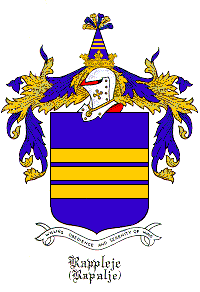 Rapalje
Rapalje Rapalje
RapaljeArms of Joris Jansen Rapalje.
ARMS- Azure, three bars or.
CREST- Issuing from a ducal coronet or, on a high hat of dignity azure, three bars of the first. The hat surmounted with six ostrich feathers or and azure.
MOTTO- Willing obedience and serenity of mind.
(Crozier: "General Armory.")
"Joris Janssen Rapalje came to New Netherlands in 1623 ("American Families of Historic Lineage" says about 1632 [a typo?]) on the ship "Unity," which was the first vessel to bring agricultural colonists to the Hudson Valley. For three years, from 1623 to 1626, he resided at Fort Orange, now Albany, but at the end of that time he removed to New Amsterdam, which was becoming a center for persecuted Huguenots and Walloons. He located on what is now Pearl Street and was residing there when his deed to the property was confirmed March 13, 1647. He had already purchased from the Indians, on June 16, 1637, a farm containing one hundred and sixty morgens or three hundred and thirty-five acres. The Indians called it Rennagaconck, while the Dutch called it Wale bocht. It was located where the present United States Marine Hospital in Brooklyn stands and also included the land between Nostrand and Grand avenues. He may have resided there for a time and been obliged to return to the city on account of Indian troubles. In 1641 Joris Rapalje was elected member of a board of twelve men to consult with Governor Kieft on account of the dangerous situation the confronting the Colony on account of unrest among the Indians. This was the beginning of representative government in the Dutch portions of America, and the board availed itself of the opportunity to strengthen such institutions by an attempt to limit the arbitrary power of the Governor, for which they wished to substitute a more democratic system. According to their plan four of their number should become members of the Permanent Council. The representative body was, however, abolished the following year. June 22, 1654, Joris Rapalje sold his property on Pearl Street to Hendrick Hendrickson and removed to his farm at Wale bocht, where he lived the rest of his life. In 1655, 1656, 1657, 1660, and 1662 he was a magistrate in Brooklyn. He apparently died about the time of the close of the Dutch administration, as his name disappears from the records of the time.
Joris Janssen Rapalje married Catalyntje Trico, who was born in 1605 {in Paris} and died September 11, 1689. She was a daughter of Joris Trico, of Paris, France, and his wife Michele Sauvagie. After the death of her husband, Catalyntje continued to reside at Wale bocht. She was seventy-four years of age at the time Jasper Dankers and Peter Sluyter, the Labodists, visited her there and described her in their journals as follows:
M. de la Grange came with wife to invite me to accompany them in their boat to the Wale bocht, a place situated on Long Island almost an hour's distance below the city, directly opposite Correlaerr hoeck from whence, I had several times observed the place which appeared to me quite pleasant-- she is worldly minded, living with her whole heart, as well as body, among her progeny which now number 145 and will soon reach 150. Nevertheless, she lived alone by herself a little apart from the others, having her little garden and other conveniences with which she helped herself.
Children: